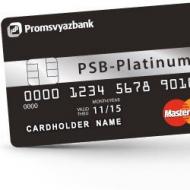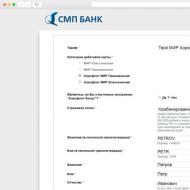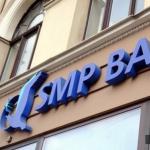
Forward How to fix a currency position. Protection against the growth of exchange rates. Areas of using currency futures
Forward deal – this is a type of transaction in which one of the parties undertakes to sell the other party a certain amount of foreign currency in a predetermined term at a particular exchange rate. In this case, the course will be listed in the Agreement.
Thanks to forward transactions, you can buy and sell currency in the future, without experienceing for possible racing prices. This opens up great opportunities for risk management businessmen, and allows not to worry about unforeseen changes in the national currency.
Consider an example of a real forward transaction:
The big Russian plant plans to conclude a contract with foreign suppliers for the purchase of raw materials with a total value of $ 300,000, which must be paid in 3 months. The plant management has come to the conclusion that the conditions are quite acceptable. So, taking into account the current dollar rate - 59r. - After 3 months it is necessary to pay 17 million 700 thousand rubles. But what will happen if suddenly ruble will fallSuppose to 65 p. for 1 dollar? Obviously, nothing good for the factory, because the amount of the contract will already be 19 million 500 thousand rubles. Here it will be very by the way forward contract. Suppose a broker provides a $ 1:50 leverage, and something like a 10% deposit (this is maximum) from the factory (this is maximum) total amount Contract, in this way, purchases guarantee for themselves the purchase of raw materials at a fixed currency rate.
Forward transactions are greatly suitable for international companies, since they allow you to protect against unforeseen cash losses. BUT B. last years The number of private investors that use such a type of contracts to protect themselves with large overseas purchases, such as real estate, or if necessary, pay for training, long business trips, etc. And more and more often the merchants are used by such a tool. financial markets In order to profit.
The main advantage of working with the currency forward, in contrast to trade in currency pairs, is the absence of swaps. An excellent option for long-term transactions, because it is not necessary to pay for daily positions. Taking into account the duration of the transaction for several months - the substantial savings of the trader deposit!
Best Forex Brokers
Alpari is an undisputed leader in Forex market and today the best broker for traders from Russia and the CIS countries. The main advantage of the broker is the reliability confirmed by the 17th works. Alpari gives traders the opportunity to earn and output profits.

RoboForex - International Broker highest level With CYSEC and IFCS licenses. In the market since 2009, it provides a number of innovative tools and platforms for both traders and investors. Famous for nothing bonus program which includes free $ 30 for newbies.
Specific features of currency forwards:
- non-sharing and mandatory contract;
- the parties must harmonize the size, time and place of delivery, the quality of the asset is specified, and other requirements of the parties are taken into account;
- this contract is not subject to compulsory reporting;
- the main advantage is a clearly fixed price for a specific date;
- as the main disadvantage - regardless of the price value, none of the parties can refuse to fulfill the contract.
Forward transactions belong to the category of urgent. To the same category range:
d) various combinations of the above transactions.
Consider another example of forward contract EUR / RUR

Firm plans to buy imported goods 2 months later. Of course, this requires a currency. In order to reduce risks, the company resorts to hedging and concludes a forward contract for the euro for 2 months.
The contract price for the date of its completion will be calculated at the next course: 69 rubles for 1 EUR. But, in the foreign exchange market, the course is constantly changing, and after 2 months, the ruble fell to 72 rubles per 1 euro. But our trading company will still receive the necessary amount at the rate of 69 p. To do this, you need to list your deposit broker.
What is the difference between the futures contract from forward
The futures contract is a fairly standard agreement between two subjects. One of them undertakes to put the basic asset in the agreed date and time, and the other to buy. Futures refers to stock exchange tools, it is trading on the stock exchange, and the rules for conducting such transactions are governed by the Rules of the Exchange.
Some differences between forward and futures:
- the forward transaction allows Parties to independently determine the amount of delivery, with futures, the volume of the contract establishes the stock exchange, and the parties can trade only a certain number of contracts;
- futures allow you to trade asset, regardless of their quality, only mutual consent is enough, futures contracts have the quality establishes the stock exchange;
- forward has limited liquidity, the futures is considered highly liquid (although this indicator varies depending on the basic asset).
Forward operations (Forward Operation or Abbreviated - FWD) are transactions for currency exchange according to a predetermined course, which are today, but the date of the currency is postponed for a certain period in the future. At the same time, the currency, the amount, exchange rate and the date of payment are recorded at the time of conclusion of the transaction. The term of forward transactions ranges from 3 days to 5 years, however, the dates in 1, 3, 6 and 12 months from the date of conclusion of the transaction are the most common.
Forward contract is bank contracttherefore, it is not standardized and can be submitted for a specific operation. The market for forward transactions with urgency up to 6 months in basic currencies is sufficiently stable, for a period of more than 6 months - unstable, while individual operations can cause strong oscillations of exchange rates.
The forward course is composed of a spot course at the time of conclusion of the transaction and award or discount, i.e. Dumping or discounts depending on interest rates interbank market for this term.
The forward course is usually different from the spot course and is determined by the differential interest rates in two currencies. Forward course is not the prediction of the future spot course. If the execution of the forward contract occurs up to 1 month, then it is considered concluded for short dates.
Forward operations are applied in the following cases:
Hedging (insurance) currency risks;
Speculative operations.
Hegertrying to reduce the risk of changing the future price or interest rate through the conclusion of forward contracts that guarantee the future exchange rate. Hedging does not increase and does not lower the expected income of the market participant, but only changes the risk profile. The principle of hedging is that the movement of courses founded Market Compensated for equal and opposite movement of the price of a hedge tool.
The bank can insure the risks of its customers. For example, foreign trade organizations that have payments and adventures in different currenciesusing forward contracts, also able to insure the risk of change exchange rates. If the company knows a schedule of sales and procurement, it can hedge the risk of a possible course change in an unfavorable side, while knowing a pre-exchange rate, the company is able to calculate its future costs and outline the right investment and pricing policies. Abroad, the market of forward contracts is much more popular than in Russia.
Suppose that the American importer of German cars must pay for the delivery to the euro, while selling cars it will be in dollars. In this case, the importer must be specified with the German manufacturer's shipping cost in the euro and calculate the sales price in US dollars. The risk of the importer is that in the time interval between the moment of concluding a contract in the euro and the actual implementation of the goods in US dollars, the dollar rate may fall. As a result of a decline in the course, the importer will be required by the amount of US dollars to reimburse the costs of a contract incurred in euros. However, when concluding a forward contract, the importer will know the exact amount in US dollars needed to convert to the euro under the contract, as well as the price of selling imported goods, taking into account the receipt of guaranteed profits.
If the dealer will buy the euro for the US dollars for the US dollars for a month at EUR / USD 0,9926, and in a month the spot course will be equal to EUR / USD 0.9960, then this operation will bring profit to the bank. For example, a currency dealer buys EUR 10 million. For the forwarding rate EUR / USD 0.9926 for a period of 1 month in order to speculate on the currency course. A month later, the bank will receive EUR 10 million on the cash date and pay USD 9.926.000.
If a spot rate on the market in the market will be EUR / USD 0.9960, then the dealer will sell Euro 10 million per dollars and will receive USD 9.960.000. As can be seen from this example, as a result of the operation, the bank's profit was USD 34.000 as a result of the fact that the dealer considered that the progenated forward-rate EUR / USD was allegedly more profitable than the future spot rate at the values \u200b\u200bdate for a forport contract. However, if the spot course is EUR / USD 0.9908, then the sale of the euro will be wrapped with a loss. The opening of currency positions in the forward market is also associated with risk, as in the case of other speculative operations.
Forward course Outrait \u003d Course Spot ± Forward Points Forward Outright Rate \u003d Spot Rate ± Forward Points
Forward items are also called swap items, forward difference or swap difference.
If the forward course is more than a spot course (FR\u003e SR), then the currency is quoted with a premium if FR< SR , то валюта котируется с дисконтом.
Forward contracting agreement between counterparties on the future supply of a basic asset, which is coming out of the exchange. Forward contract - an urgent solid deal, that is, a transaction, mandatory for the execution of each party. Since the forward contract is a non-genise instrument, its conditions (BA zis asset, size, term, price) - not standardized. For varying contracts are used for speculative goals and hedging of market risks. The principle of market risk management using forward contracts is to eliminate not a certainty (source of risk) by fixing the price and the same to the mums of the risk of counterparty (as a speculator or another hedger can be. The cost of hedging with the power of forward contracts includes the costs associated with the search for the counterparty under the contract and the procedure for its conclusion. Hedging coefficient B. this case Equal is 1, that is, one unit of the hedging instrument is required to compensate for the risk of one unit of the asset (currency).
The currency forward contract is an agreement of counterparties for the purchase or sale within a certain period of time in the future defined amount of foreign currency on the conditions defined at the time of the contract.
Forward contract design:
- ? Currency type (for example, US dollars);
- ? Contract size (for example, $ 1000);
- ? The size of the warranty contribution (% of the contract size);
- ? warranty fee;
- ? contract execution - execution date;
- ? contract contract - forward exchange rate.
Usually forward contracts have a specific execution date. However, situations are possible when necessary, for example, to ensure the delivery of currency, but the delivery time is not exactly defined. In this case, it is possible to purchase a forward contract with open time execution in the form of a forward option, the execution date is not a date, but a certain period of time, and the contract buyer receives the right to choose any date in this period.
Fixing in a contract of the future currency (former) course allows the buyer of the contract to completely eliminate the uncertainty as to, for example, how much the sums of future payments or income in the national currency will also avoid losses in the event of unfavorable nice changes in the foreign exchange rate in the future. At the same time, the prisoner does not allow him to make a profit in case of a favorable course change.
The forward course reflects the expected cost of the currency after a certain period of time and represents the price on which this currency is sold or bought under the condition of its delivery in the future. Theoretically, the striker course can be equal to the spot, but in practice it always turns out to be either higher or lower. If the forward course above the spot course, it will be equal to the amount of the spot and the corresponding difference - forward margin, which is called a prize in this case. If the forward rate is below the spot course, it is a spot spot from which the forward margin is deducted, in this case discount. If the forward currency rate exceeds the spot rate, then the currency says that it is quoted with a premium. And on the turn, if the forward course is below the cash, then the COTI currency is rushing with a discount (discount).
As the basis for calculating the currency rate of the forward currency and the current currency, their theoretical course forward (R ft) may be considered, the value of which is determined on the basis of parity of the currency percentage rates A (Ia) and currency in (Ib), taking into account the execution period Forward contract (T). The value of the theoretical course forward is determined by the formula
wherer ft -forward course
R SAB - Course Spot A / B;
FM-forward margin.
It follows from this expression that if the interest rate on the quoted currency in more rates on the quoted currency A, the rate of forward A / V will be more than Spot rate, i.e. Currency and quoted with a premium. If the interest rate according to the quoting currency is less than the rate on the quoted currency A, the rate of forward A / V will be less than Spot rate, i.e. Currency and quoted with discount. The premium (or discount) compensate the difference in interest rates between deposits in two currencies.
Currency hedging operations can be implemented using various types of forward connotations: delivery (purchase / sale with a real delivery of currency) or calculated (without real delivery of the currency with the bouncing of that margin).
Under the terms of the delivery forward contract, the Bank has a battlefield from the client or sells it a stipulated amount of currency with delivery on a specific day according to the contract specified in the contract. In turn, the client undertakes to list the bank no later than the delivery date of the amount in the currency (when selling foreign currency) or rubles (when buying foreign currency).
If necessary, the client may close its currency position Through the conclusion with the Bank a counter-forward contract with the same day of execution, but otherwise, as a rule, the forward course. Thus, there is a mutual understanding of obligations with the payment (obtaining) the difference between the ruble assessment of the purchase or sale of the currency at the values \u200b\u200bdate.
The subject of the contract of settlement forward contracts is not cash currency, And the currency rate. As a rule, the calculated oddic contracts are concluded russian banks For a period of 3 days to 3 months. The use of forward settlement contract is particularly attractive to clients (enterprises, organizations), which do not have a settlement or currency account in the Bank - the seller of the forward contract. They can envelse currency in one bank, and the associated currency risk is covered in another.
If, with an unfavorable change in the exchange rate, the company, having been convened, will incur losses (the planned amount of income will not receive), then the margin of the calculated form of a varying contract can fully compensate them. The bank - the seller of the settlement forward contract fully assumes the risk of loss in the event of an adverse currency rate for the client. However, with a favorable change in the literal course, the client loses the opportunity to get a speculative profit, which becomes the bank's income.
Calculations by this kind Forward contracts are produced by the listing of some amount (margin), defined as follows:
margin \u003d [Forward course (contract execution) - SPOT-currency rate for the day of calculation] H contract volume.
Wherein:
- ? If the margin is negative, the seller of forward contracts (bank) pays it to the buyer of the contract (client);
- ? If the margin is positive, the buyer pays her seller.
Consider how a forward contract is used for a currency risk. For example, take the Russian company - the importer that buys for your own or borrowed funds Abroad goods, imported it to Russia and sells for rubles. Then the importer converts rubles to foreign currency For something to buy goods again. At the same time, there is a possibility to notice the planned profits due to the unforeseen devaluation of the ruble, especially at the stage of reverse conversion, and on the racing additional profit in the case of its strengthening.
The importer in January signs a contract with a German firm for the supply of household appliances in the amount of 100 thousand euros and its payment in April. The magnitude of the possible profits and losses of the importer for hanging from the magnitude of the future (April) currency rate. To them, Porter can conclude a forward contract with the Bank for the checkout of the currency, thereby having a currency risk.
Option 1. In January, it concludes a supply forward contract with the bank with the bank for the purchase of currency (buys 100 thousand euros in January with the supply of the relay on the forward course 45.80 rubles / euro).
A. In the case of increasing the actual exchange rate of the ruble in April over the vehicle dandy (for example, up to 45.70 rubles / euro), the importer has lost profits in the amount of 10 thousand euros, which will receive a bank by purchasing 100 thousand euros on the market The course is 45.70 rubles. / Euro and selling their client for 45.80 rubles. /Euro:
(rub. / Euro) h 100 000 (Euro) \u003d 10,000 rubles.
B. in the case of lowering the market course in April to 45.90 rubles. / Euro importer runs losses in the amount of 10 thousand rubles, which will incur bank, acquiring a currency at a market rate of 45.90 rubles. euro and selling it to the client at the rate of 45.80 rubles per euro:
(rub. / Euro) h 100 000 (euro) \u003d -10 000 rub.
The result of the hedging of currency risk for the importer using the supply forward contract: the actual conversion rate for any development of events in the foreign exchange market amounted to 45.80 rubles. /Euro.
Option. 2. In January, concludes a settlement forward contract with the bank in the amount of 100 thousand euros per currency course / RUB; the term of execution is April. In this case, the importer will buy in April euros on the currency of the number of the market in the market at the market, and the bank will pay (to be used) by Margin (the difference between the market and forward course).
A. So if the April course "Spot" will be 45.90 rubles. / Euro, then the costs of the Import of Thera on the purchase of 100 thousand euros will be:
45.90 (rub. / Euro) h 100 000 (Euro) \u003d 4,590,000 (rub.)
The bank will pay in the calculated forward contract by Margin in the amount of:
(rub. / Euro) h 100 000 (euro) \u003d 10 000 rub.,
what will reduce the real extents of the importer to the purchase of currency up to 4,580,000 rubles.
B.Isli April course "Spot" will be 45.70 rubles / euro, then the importation costs for the purchase of 100 thousand euros will be:
45.70 (rub. / Euro) h 100 000 (Euro) \u003d 4 570 000 rub.,
however, at the same time, the client must pay the bank according to a calculated forward contract by Margin in the amount:
(rub. / Euro) h 100 000 (euro) \u003d 10 000 rub.,
what will increase the real cost of importer to the purchase of 100,000 euros to 4,580,000 rubles.
The result of hedging for the client using a settlement contract: the actual course of conversion in any development of events in the foreign exchange market amounted to 45.80 rubles per euro.
Forward contracts are actively used in contemporary world practice for currency risk management in the following reasons:
first, forward contracts take into account all the individuals (often very specific) hedger needs regarding the volume and terms of execution of the contract, which makes them a more convenient hedging instrument, compared with the same standardized exchange tools;
secondly, despite the fact that the forward markets are not regulated government agencies, the risks are small on them, as the main participants are the world's largest banks, the reputation of which, as potential counterparties on the transaction, is very high;
thirdly, the degree of development of modern communications on wheels to find a potential counterparty in any country, carry out negotiations and conclude an agreement with it without significant temporary costs and related costs;
fourth, banks are the main participants of the international forward market, are currently significantly advanced in the field of standardization and unification of the conditions of forward contracts and the procedures for its conclusion, which significantly increases the liquidity of this tool.
The main advantage of the forward contract is the possibility of satisfying individual requests of the parties to any parameters of the transaction (sizes, deadlines, price). In addition, forward contracts can be to any currencies, and not just the most common (as, for example, in the case of futures), as well as any non-standard timing. In addition, the parties entering forward contract are usually not carried additional expenses in the form of brokerage commissions. The unconditional advantage of forward contracts - the possibility of their conclusion for long terms exceeding the time exchange Tools. For example, futures contracts are usually concluded for a period of up to one year, and Forwards may be concluded for a longer time (up to several years), although the final decision for hedger with a long horizon is a swap, which can be considered as a series of forward contracts.
You can call two shortage of forward contracts. Perception is higher (compared to futures) the risk of non-fulfillment of the counterparty under the forward contract. The second is the inability to often complete the transaction on a forward contract or abandon its use. This is due to the fact that the forward contract involves the mandatory supply of currency as a result of its execution, which makes it not flexible enough. Unlike futures contexts having a high degree of standardization, forward markets are less liquid and therefore characterized by nice at the prices of the seller and the buyer.
Forward operations Forward Operation or abbreviatedfWD. ) - These are transactions for the exchange of currencies according to a predetermined course, which are today, but the date of the currency is postponed for a certain period in the future. At the same time, the currency, the amount, exchange rate and the date of payment are recorded at the time of conclusion of the transaction. The term of forward transactions ranges from 3 days to 5 years, however, the dates in 1, 3, 6 and 12 months from the date of conclusion of the transaction are the most common.
Forward contract is bank contract, Therefore, it is not standardized and can be submitted for a specific operation. The market for forward transactions with urgency up to 6 months in basic currencies is sufficiently stable, for a period of more than 6 months - unstable, while individual operations can cause strong oscillations of exchange rates.
The forward course is composed of a spot course at the time of conclusion of the transaction and award or discount, i.e. Dumping or discounts depending on the interest rates of the interbank market for this period.
The forward course is usually different from the spot course and is determined by the differential interest rates in two currencies. Forward course is not the prediction of the future spot course. If the execution of the forward contract occurs up to 1 month, then it is considered concluded for short dates.
Forward operations are applied in the following cases:
· hedging (insurance) currency risks;
· speculative operations.
Heger Trying to reduce the risk of changing the future price or interest rate through the conclusion of forward contracts that guarantee the future exchange rate. Hedging does not increase and does not lower the expected income of the market participant, but only changes the risk profile. The principle of hedging is that the movement of the exchange rate market compensates for the equal and opposite movement of the price of a hedge tool.
The bank can insure the risks of its customers. For example, foreign trade organizations that have payments and receipts in different currencies using forward contracts are also able to insure the risk of currency exchange rates. If the company knows a schedule of sales and procurement, it can hedge the risk of a possible course change in an unfavorable side, while knowing a pre-exchange rate, the company is able to calculate its future costs and outline the right investment and pricing policies. Abroad, the market of forward contracts is much more popular than in Russia.
Suppose that the American importer of German cars must pay for the delivery to the euro, while selling cars it will be in dollars. In this case, the importer must be specified with the German manufacturer's shipping cost in the euro and calculate the sales price in US dollars. The risk of the importer is that in the time interval between the moment of concluding a contract in the euro and the actual implementation of the goods in US dollars, the dollar rate may fall. As a result of a decline in the course, the importer will require a better amount in US dollars to reimburse the costs of a contract incurred in euros. However, when concluding a forward contract, the importer will know the exact amount in US dollars needed to convert to the euro under the contract, as well as the price of selling imported goods, taking into account the receipt of guaranteed profits.
If the dealer will buy euros in the speculative purposes for US dollars for a month in the courseEUR / USD. 0,9926, and in a month the spot course will be equalEUR / USD. 0.9960, then this operation will bring a profit to the bank. For example, a currency dealer buysEUR 10 million in the forward courseEUR / USD. 0.9926 for a period of 1 month in order to speculate on the currency course. A month later, the bank will receive the bankEUR 10 million and payUSD 9.926.000.
If the spending rate on the market in the market will beEUR / USD. 0,9960, then the dealer will sell Euro 10 million per dollars and getUSD. 9.960.000. As can be seen from this example, as a result of the operation, the profit of the bank amounted toUSD. 34.000 As a result of the fact that the dealer considered that the protected forward courseEUR / USD. Presumably more profitable than the future spot rate at the values \u200b\u200bdate on the forward contract. However, if the spot course isEUR / USD. 0,9908, then the sale of the euro will result in a loss. The opening of currency positions in the forward market is also associated with risk, as in the case of other speculative operations.
Forward course Outrait \u003d spot spot ± Forward points
FORWARD OUTRIGHT RATE \u003d SPOT RATE ± FORWARD POINTS
Forward items are also called swap items, forward difference or swap difference.
If the forward course is more than spot course (FR\u003e Sr. ), then the currency is quoted "with a premium" ifFr.< SR The currency is quoted "with discount".
Size of forward discounts or currency premiums
FD (P M; DIS) \u003d
where fd (p m; dis ) - forward differential (premium or discount);
Fr. - forward course;
SR - spot course;
t. - term (in days) actions of a forward contract.
Prizes and currency discounts are translated on the annual basis so that it is possible to compare the yield from the currency attachment to the forward transaction with the yield from investment in the money market tools.
Daily International Financial Pubs TypeTHE W A LL STREET JOURNAL AND FINANCIAL TIMES Print current spot courses (spot rates. ) and forward courses (forward Rates. ) for 30, 90 and 180 days, also provides this information agencyReuters.
On the forward market, banks also quote the purchase rate and currency sales and respectively calculate the cross-course. At the same time margin between the exchange rate of the currency and the course of its sale (AFR - bfr. ) More under forward operations and is 0.125-0.25% per annum, while at the Spot rate - 0.08-0.1% per annum.
Forward items are absolute items of this exchange rate (in the Currency Currency Units), which is adjusted to the spot during forward operations, and reflect the interest rate difference for specific periods between the currencies sold in international money markets, the percentage differential.
There are two basic quotes methods. forward courses: Method outrait and method swap beta.
When quoted by the Outrait method, banks indicate customers as a complete spot course and a full forward course, as well as the term and amount of the delivery of the currency.
In most cases, in the interbank market, the forward course is quoted using swap rates. This is due to the fact that dealers are operated by forward margins (that is, discounts or prizes) expressed in points that are called swap courses or swap-rates. Forward margins were distributed for the following reasons:
· they most often remain unchanged, while Spot courses are subject to large fluctuations; Thus, in the quotation of premiums and discounts, it is necessary to make less changes;
· when concluding many transactions, you need to know the size of the forward margin, and not a complete forward course.
There is a rule according to which:
· a currency with a low interest rate for a certain period is quoted on the terms of forwards to a currency with a high interest rate over the same period with a premium;
· the currency with a high interest rate for a certain period is quoted on the terms of forwards to a currency with a low interest rate for the same period at a discount or discount.
The main reason for the difference in the course of SPOT and forward course is the difference in interest rates on deposits of two currencies. Suppose that the forward course and the Course of the US dollar to Japanese Jena areUSD / JPY. 125.0000. Interest rates on dollar deposits 10%, while the banking rate on the yen is equal to only 4% per annum. Then investors would buy US dollars and place them in dollar deposits with a higher return. At the end of the term, investors would be able to back to proof US dollars in Japanese yen. At the same time, the resulting income from the operation would be used to the amount of possible income from the placement of the deposit in yen at a rate of 4% per annum.
Thus, assuming that the spot course and forward course are equal, then calculating the yield of deposits in dollars and yen, investors would conclude 2 contracts at the same time:
1. purchase US dollars on space at the rate of 125,0000
JPY 125.0000 \u003d USD 1.0000
2. forward contract (transaction outrait) for sale dollars (that is, buying back yen) in the same course of 125.0000 on the end of the deposit in the deposit amount and accrued interest:
USD 1008.33 00 \u003d JPY 126.041 0
At the same time the amount of placementJPY. 125.000 in a deposit under 4% would be allJPY 125.417.
If practices were respected by the equality of courses, then investors would rush to convert currencies and place deposits with a higher yield, as a result of which the exchange rate for this currency would instantly collapsed, or would fall interest rates on deposits in another currency. Theoretically, the forward course is equal to the spot rate only subject to the equality of interest rates in currencies for this period.
In the above example, the forward course should actually be higher than the spot course for some value that allows you to level the difference in interest rates when performing inverse conversion in the future under forward conditions.
There is a rule according to which:
· a currency with a low interest rate for a certain period is quoted on the terms of forwards to a currency with a high interest rate over the same period with a premium.
· a currency with a high interest rate for a certain period is quoted on the terms of forwards to a currency with a low interest rate over the same period with discountor Discount.
To get a forward course based on the current exchange rate, you should add or subtract forward items from the spot course. Actions are determined by the scheme shown in Table 8.
Table 8.
|
Forward points |
Basic currency trading |
Forward course raven |
|
Higher value Goes first High / low |
with discount |
spot course minus forward points |
|
Lower value Goes first Low / high |
with a premium |
spot rate plus forward points |
Thus, the forward course is calculated by adding a premium or subtracting the discount from the current spot rate. To calculate forward items, traders use two formulas. Formula 1 gives more accurate results. Formula 2 does not give such an accurate result, but makes the calculation easier.
Formula 1
Forward course Spotx. (% currency -% base currency) x. Number of days
points \u003d. (% base currencyx. Number of days) + 360 x 100
Formula 2.
Forward course Spotx. Differential interest rates x. Number of days
Points \u003d 100 x 360
Here, interest rates on currencies will refer to the period (the number of days) for which the forward course is calculated.
Instead of 360 days, adopted for most currencies as a percentage base, for pounds of sterling, rubles, Canadian, Singapore dollars must be considered 365/366 days.
If the obtained forward points will have a positive sign, they are a premium and will be added to the spot rate; In the case of a negative sign, they will be a discount and deduct from Spot.
Forward points can always be determined based on the well-known interest rates of currency participating. Formulas 1 and 2 are applicable for any currency pairs, including couples with cross-courses.
According to these formulas, you can calculate the average forward points for the middle course of the Outrait (without accepting partiesbid and Offer. ). However, both the course of SPOT and the course of the outrait are quoted by banks in the form of a dual quotation. Forward items are also calculated asbID and OFER:
Formula 3.
Forward spotbid. x. (% Currencybid. -% Baseoffer.) x. Number of days
points Bid \u003d Offer X Number of days)
Formula 4.
Forward spotoffer.x. (% Currencyoffer. -% Basebid.) x. Number of days
points Offer \u003d. 360 x 100 + (% base currencybID X Number of Days)
Example of calculating 3-month forward pointsbid and Offer. For the course of the US dollar to the euro.
Euro / USD quotation 1.0531 - 1.0536, or 31/36.
3-month deposit rates in US dollars and the euro are (Table 9):
Table 9.
|
Offer. |
||
|
points Bid \u003d 360 x 100 + (4 x 90)
|
clauses Offer \u003d 360 x 100 + (3 x 90)
The quotation of forward items represented by the bank dealer will look like this:
Bid Offer.
EUR / USD. Course SPROT 1.0531 1.0536
3 months. Forward. P-you 26 78
3-month Cours Outrait 1.0557 1.0 614
* The meaning of this action lies in the calculation of the costs of lost opportunity, that is, concluding a deal, the dealer loses the possibility of placing the same funds to the deposit
To find the forward course, the outrait dealer folded forward points and spot quotes, respectively,bid and Offer. On the side of Bid Similarly, as in the case of the SPOT Course quotes, the Bank, the quotation of the forward course, will buy the basic currency (in this case, the euro) against US dollars under the terms of delivery in the future. On the sideoffer. The bank will sell the basic currency on the terms of the forward. Calculations carried out by bank dealers are made automated by using a special software According to the algorithms above.
The magnitude of margin (spread) between the partybid and side offer When quoting forward points and a course, outrait depends on the same factors as in the implementation of the sewage quotes, that is, on the nature of the counterparty, the market situation, the amount of the amount, etc.
For a currency dealer working in international markets, the Reuters Agency provides information on the current values \u200b\u200bof forwarding stakes for standard terms. If the dealer of one bank requests a forward quotation in another bank, then he shifts forward items, for example, 26/78 or 199/198. Sailing forward points is much more convenient, as they depend on percentage differentials and change less frequently than spot courses.
For simplicity of the forwarding course, dealers use the following rule:
· if forward items grow from left to right (quotationbid Less quotesoffer. ) - To find the course, outrait forward items are added to the Spot rate;
· if forward points decrease left to right (sidebID More Side Offer ), To find the course, outrait forward items are deducted from the spot.
In the information pages, the Reuters decreasing from left to right forward points for the convenience of perception are additionally supplied with a negative sign, indicating that they should be deducted to obtain a forward course.
For example, a currency dealer requires a 6-month course of an outralet pound sterling to the US dollar. Since interest rates on pound sterling higher than in US dollars, the pound will be listed to the dollar at a discount (or it can be said that the dollar will be quoted to a pound with a premium). The dealer uses the Reutert pageFWDW. where for a period of 6 months (6m) finds the following quotation of 6-month forward points: -199 / -198. Current spot spotGBP / USD. This is 1.5603 / 13. Since forward points declow from left to right, they should be deducted from Spot:
GBP / USD Spot 1.5603 / 1.5613
6 MTH FWD POINTS - 199 - 198
6 MTH GBP / USD OUTRIGHT 1.5404 1.5415
Sometimes forward items in the same two-sided quotation and subtracted, and added: - 1.0 / + 1.0, which means "around parity" (round Par. .). This happens with a very insignificant interest rate differential. So, on the screen you can see the quotation -1.0 / + 1.0. In this case, the trader says: "One of the parity." Parity is zero. Quotation - 3.0 / + 3.0 read as "three from parity". Also found the quotepAR / 3 or 3 / PAR . The quotations apply similar arithmetic actions to obtain a forward course.
The size of forward items for dat. (broken Dates. ) It can be designed by the formula and also taken from the pages of the Reuters agency in the form of ready-made forward items. Dealers concluding a forward transaction with a broken date should be taken into account that the market of such operations is less liquididen, rather than the market of transactions with standard timing, and it can be difficult to find a counterpart for it to close.
Suppose that forward items for standard periods with direct dates are:
2 months 31 - 47
3 months 55 - 74
The difference between forward points for 2 and 3 months is:
For side BID 55 - 31 \u003d 24
For the side of Offer 74 - 47 \u003d 27
For one day, the forward points of the 2nd month (the period between the 2nd and 3rd month) is respectively:
For side BID 24/30 \u003d 0.8
For the side of Offer 27/30 \u003d 0.9
For 10 days of the second month, forward items will be:
bid Offer.
0.8 x 10 \u003d 8 0.9 x 10 \u003d 9
The desired forward points for a period of 2 months and 10 days will be:
31 4 7
+8 +9
39 – 5 6
Swap rates that are listed in bank information systems are given only for full months or for the so-called direct dates. If the spot currency date coincides with the last day of the month, then in this case there is a "end of the month" rule, in which all forward transactions on a similar spot course have a values \u200b\u200bdate on the last day of the month. For example, if a 6-month forward transaction was imprisoned on February 26, then the corresponding spot date will be February 28, i.e. the end of the month. Consequently, this forward transaction must be paid 31, and not on August 28. All other dates that do not obey the rule of the "end of the month" are called broken dates. In this case, swap points are calculated through recalculation into the daily rate of difference in swap points for two direct dates.
To the positive points of urgent operations can be attributed to what they represent great capabilities for maneuver, especially if the forward operation is not directed against specific assets or liabilities. While SPOT operations must be fulfilled almost immediately, simple forward contracts leave time to monitor liquidity control and conducting adjustments.
The forward market is important for managing financial departments of companies, since they can determine the cost of import or exports to national currency Long before the date of payment. When the financial manager concludes an urgent contract with the bank, its main task is to not stay with an open currency position, if for any reason it will not be received a product or payment. Professional dealers, having unlimited market information, have wider opportunities for maneuver than their commercial colleagues. At the same time, there are significant risks associated with urgent transactions. The longer the term of the forward contract, the greater the danger that the creditworthiness of the counterparty on the transaction may worsen. The probability of cancellation of the contract under the conditions of spot is significantly lower than the forward. In this case, the most "unsuccessful" is the option in which one of the parties performs the terms of the transaction, and the other is not. This can lead to a loss of a significant amount or expensive legal process.
In Russia, the forward market is much less developed than spot transaction market, which is explained by the preferential orientation of the market for short-term operations.
To exchange urgent currency operations Options I. futures contracts. However, at present, trade contracts are engaged and commercial banks, Especially widespread such trade received in Switzerland.
Forward contract - A specific contract concluded between the two sides about the upcoming delivery of the basic asset.
Having a contract condition, negotiated during its conclusion. A forward contract is performed on the basis of these conditions and within the deadlines.
What are the peculiarities of the forward contract?
The conclusion of the forward contract does not provide any expenses, with the exception of those commissions that will be spent on the design of the transaction, if it is performed using an intermediary.
Concludes forward contract, Usually, with the purpose of buying or selling the necessary asset, besides the insurance of the supplier or a certain buyer from a potentially unwanted price change. Counterparties are insured against the unwanted development of events without having to take advantage of a potentially favorable environment.
In the conditions of the forward contract, the obligation of execution is stipulated, but in spite of these counterparties are still not insured 100% of its non-fulfillment. For example, due to the unscrupulousness of any of the participants in the transaction or bankruptcy of the company. Therefore, before concluding a deal, you need to make sure the solvency and reputation of both parties.
Also, the forward contract can enter into which the goal is to play at the difference of the cost of assets. Analyst, making a purchase, expects to increase the price of basic assets, and the sales analyst is calculated on the decrease in the price of assets.
According to its main purpose, the forward contract is considered an individual type of contract. For this reason, other markets of forward contracts for the most proportion of assets are poorly developed or not developed at all. The exception here can be forward.
When signing a forward contract, both sides stipulate the price of the prisoner. Such a price is referred to as the price of delivery, after which it remains constant throughout the entire period of the action of this forward contract.
With the advent of the forward contract, the concept of a certain forward price appeared. Regarding each time interval, the forward price, for the current base asset, is the price of delivery marked in the contract signed to this time.
Legal feature and types of forward contracts
We will analyze in more detail legal features Forward contracts. As we have already spoken, the forward type of contract, implies the real delivery of any product, as a final result. Since the facility forward, serves as a real product, that is, things available at the disposal. With all this, the reference to the validity of the goods should not infringe upon the right of selling, to conclude a contract for the sale of goods, which will be made or acquired by a person selling goods in the future.
The forward contract leads to execution, after a while, after it is directly imprisoned.
Forward is the justified possibility of insurance insurance.
Before concluding such a contract, its important conditions are negotiated, namely:
- timing
- total product
- its price, which is not performed before the onset of a specific delivery time.
This type of risk insurance is called hedging on the market. The basic price of goods in all forward transactions is different from its price on cash transactions. In addition, it can be installed both during the signing of the contract and during the calculation and deliveries.
The cost of execution according to the forward transaction, (which is determined for the period of its implementation) serves some average stock price for this product.
Forward price, this is the result of the evaluation by the participants of all possible factors affecting the market, and all further prospects for the development of related events on it.
Price ratio in forward contracts
In the process of the development of the foreign exchange market, forward contracts began to divide into the following types of delivery methods:
supply type of forward contracts;
further, settlement forward contracts, in other words, the non-estimated types of forward contracts.
As for the delivery contracts, the delivery on them is calculated initially, and the mutual calculation is made by paying one of the parties the resulting difference in the cost of the goods or the previously established amount, on the basis of the terms of the contract.
When working with settlement types of contracts, delivery of goods (i.e., the base asset) is not envisaged from the beginning of the transaction. Such contracts allow payment to the losing party to the established amount of money, the difference between the highest price, specified in the contract and currently in the current time on the market at a specific date.
The calculation for this amount (called another variation margin) is made at the previously appointed time, as a rule, with respect to the delivery of the base.
Definition of forward price
Based on the theory, during the definition of forward price, usually allocate 2 concepts:
The first is that the forward price arises as a consequence of the upcoming expectations of all participants in the urgent stock exchange, in relation to the coming price of sob.
The second type of concept is based on the arbitration method. According to the provisions of the primary concept, all participants in the economic relationship are trying to take into account and consider all the information they have relative to the upcoming conjuncture and establish the price of the future spot.
A arbitration approach is built on the basics of technical interconnection between the current spot and forward prices, which is established without possible risk.
The arbitration approach is based on the following position: on the basis of a financial decision, the investor must be indifferent in obtaining a basic asset on the spot market at present or by the forward contract in the subsequent.
Throughout the action of the forward contract, income on shares will be or paid, or not.
If a profit is charged on the action on the action contract, then it is necessary to change the forward price for its magnitude, because by signing the contract, the investor will not receive his dividends. Moreover, there is a definition of the forward price of the currency itself based on parity% of rates, which is that the depositor is obliged to receive equal income from accommodation money Under a certain percentage without significant risk in foreign, and necessarily.
Forward contract and mutual obligations















